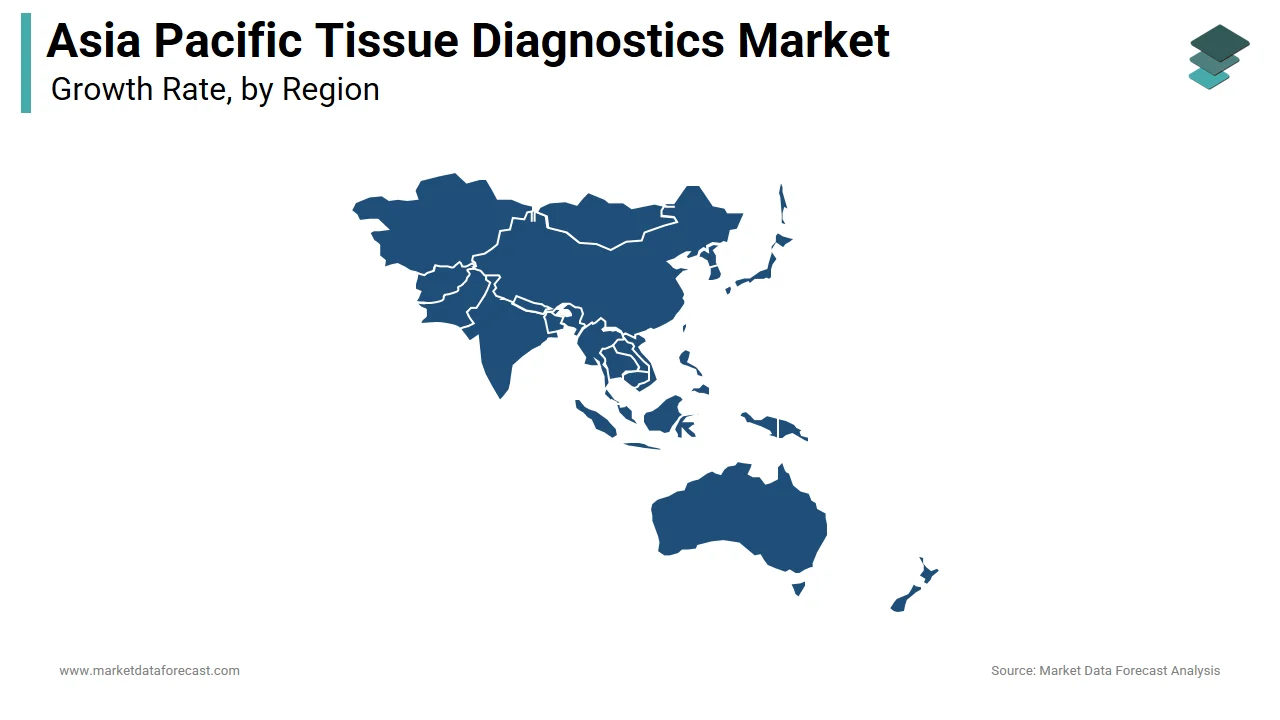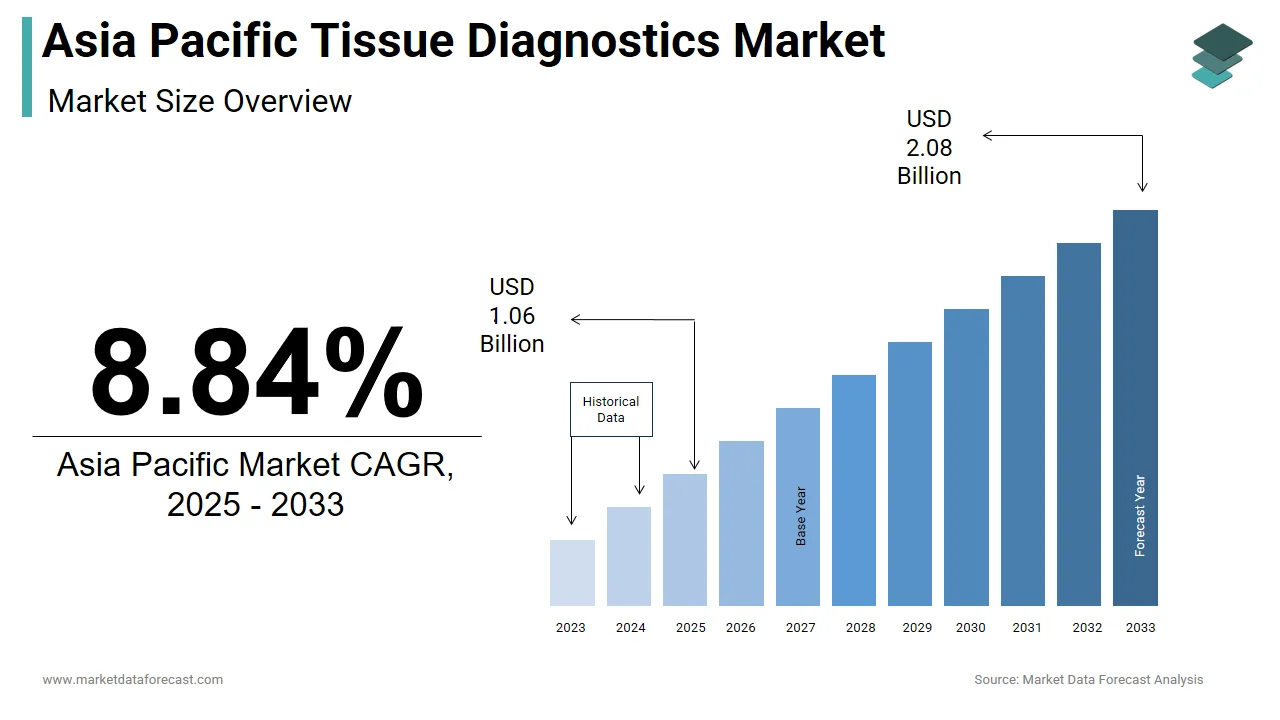Asia Pacific Tissue Diagnostics Market Size, Share, Trends & Growth Forecast Report by product type, disease, application, end-user, and Country (India, China, Japan, South Korea, Australia, New Zealand, Thailand, Malaysia, Vietnam, Philippines, Indonesia, Singapore & Rest of APAC) - Industry Analysis From (2025 to 2033)
Asia Pacific Tissue Diagnostics Market Size
The size of the Asia Pacific tissue diagnostics market was worth USD 0.97 billion in 2024. The Asia Pacific market is anticipated to grow at a CAGR of 8.84% from 2025 to 2033 and be worth USD 2.08 billion by 2033 from USD 1.06 billion in 2025.
MARKET DRIVERS
Rising Cancer Incidence, Lifestyle Changes, and Government Programs Fuel
Tissue-based diagnostic tests are performed to screen, diagnose, and monitor cancer patients' response to therapy. The tissue diagnostics market's scope includes major technologies like In Situ hybridization, IHC, digital pathology and workflow, special staining, and products such as instruments and consumables to determine medical information to diagnose diseases or conditions.
Tissue Diagnostics market expansion is expected to be driven by rising cancer prevalence, rising healthcare costs, and increased funding for research activities aimed at creating cancer treatments.
Other factors such as increased lifestyle changes, rising food and tobacco consumption, alcohol consumption, and an increase in prevalent lifestyle problems are expected to boost the market growth.
The tissue-based diagnosis method aids in determining the cause and effect of a patient's illness. The number of cancer incidents is increasing each year as a result of people's unhealthy lifestyles, boosting the demand for tissue-based diagnosis.
A cancer diagnosis and therapy at an early stage will increase the chances of survival. Therefore, the Diagnostics market will develop significantly as labs are forced to improve diagnosis efficiency to ensure patient health security.
The tissue diagnosis technique is one of the highest achievements in cancer diagnosis, and it is the market's most important driver.
On the other hand, the growing number of government programs raised awareness about the need for early cancer detection to propel the tissue diagnostics market forward.
Furthermore, factors such as increased investments in research and development of new technologies, the emergence of efficient and accurate products, growing demand for personalized medicines, and untapped market potential due to a lack of efficient Diagnostics tests for non-small lung cancer detection are expected to provide lucrative opportunities for tissue Diagnostics market growth. Furthermore, the growing scale of healthcare institutes is expected to boost demand for the tissue diagnostics market.
MARKET RESTRAINTS
However, the market growth is hampered by a small customer base for tissue Diagnostics, restricted budget constraints, and regulatory framework issues.
GEOGRAPHICAL ANALYSIS

The Asia Pacific tissue diagnostics market is anticipated to witness significant growth during the forecast period. The market growth is attributed to increased healthcare spending, growing infrastructure for cancer Diagnostics, and government assistance. Moreover, increased attention of government and private sectors in developing nations such as China. Japan, India, and other, the Asia Pacific market is expected to grow significantly during the forecast period. China, India, Japan, Korea, Indonesia, and Australia, according to the World Health Organization (WHO), are the primary regions with the highest number of cancer patients. As a result, Western medical devices companies are interested in expanding their operations in the Asia Pacific tissue Diagnostics market and medical devices business. Every year, an average of 70 million newly diagnosed patients are documented in the Asia Pacific region, according to the Cancer Index Organization. As the population of senior people grows, so does the risk of cancer, which means there is a lot of growth in the diagnosis market. The Southeast Asian countries are rapidly developing economically and investing heavily in the healthcare sector.
China accounted for the largest share of the tissue diagnostics market. The market growth is driven by the technological advancements in the healthcare sector, the presence of key market players, and favorable reimbursement policies.
On the other hand, the Indian tissue diagnostics market is one of the fastest-growing countries. The factors such as improving the rising healthcare sector, active, supportive government policies, and growing awareness are fuelling the market growth.
KEY MARKET PARTICIPANTS
Some of the noteworthy companies dominating the Asia Pacific tissue diagnostics market are F. Hoffmann-La Roche AG, Sigma-Aldrich Co. LLC, Abbott Laboratories, Agilent Technologies, BioGenex, Danaher Corporation, Cell Signaling Technology, and Ventana Medical Systems.
MARKET SEGMENTATION
This Asia Pacific tissue diagnostics market research report is segmented and sub-segmented into the following categories.
By Product Type
- Instruments
- Microscope
- Non-contact Handheld IR Thermometer
- Haemocytometer
- NMR Tube
- Others
- Consumables
- Reagent kits
- Others
By Disease
- Lung cancer
- Lymphoma
- Pancreatic cancer
- Breast cancer
- Others
By Application
- Hematoxylin & Eosin
- Immunohistochemistry
- In Situ Hybridization
By End-user
- Hospitals
- Diagnostic laboratories
- Research Organizations
- Contract Research Organizations
- Biotechnology Companies
By Country
- India
- China
- Japan
- South Korea
- Australia
- New Zealand
- Thailand
- Malaysia
- Vietnam
- Philippines
- Indonesia
- Singapore
- Rest Of APAC
Related Reports
Access the study in MULTIPLE FORMATS
Purchase options starting from
$ 2000
Didn’t find what you’re looking for?
TALK TO OUR ANALYST TEAM
Need something within your budget?
NO WORRIES! WE GOT YOU COVERED!
Call us on: +1 888 702 9696 (U.S Toll Free)
Write to us: sales@marketdataforecast.com

